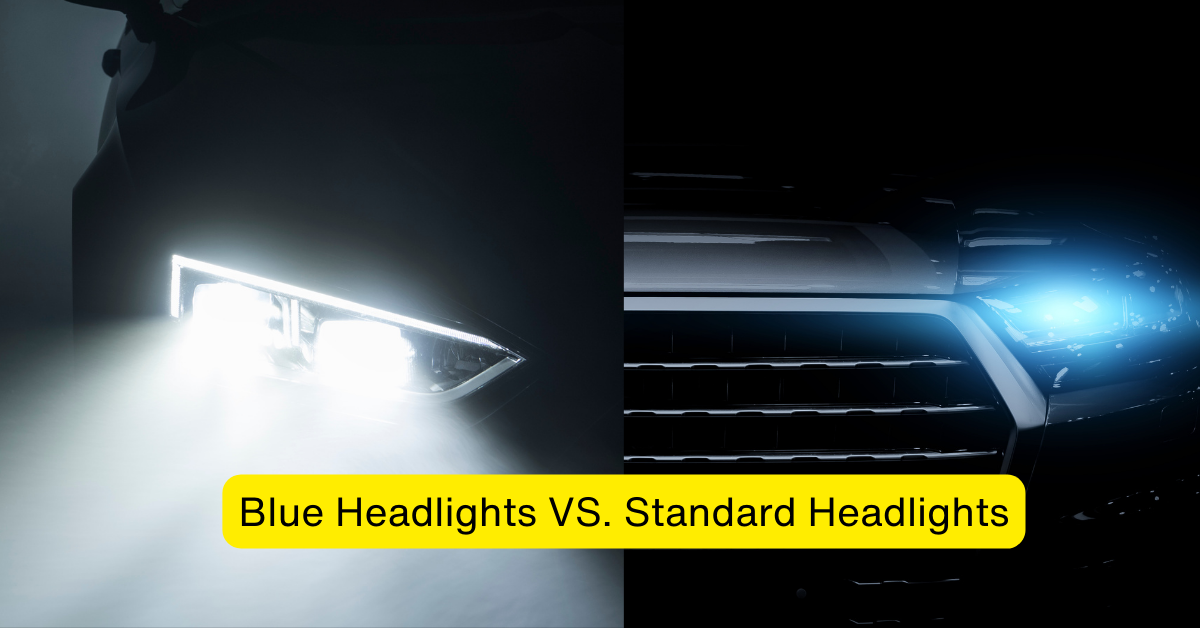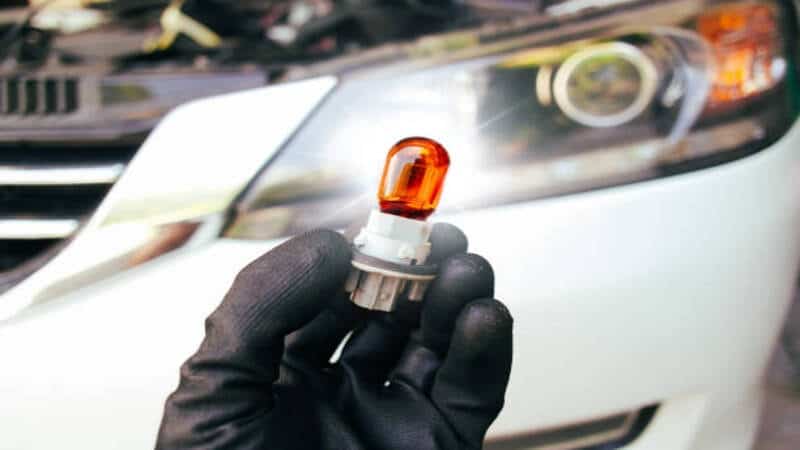Nowadays, cars come with different types of headlights. While yellow and white lights are pretty common, blue headlights seem to be a new and exciting trend. They give the vehicle a unique look and make it stand out on the road. However, there are other types of blue headlights, and not all of them are legal. So, what are blue headlights, and are they illegal?
Today, we will give you a complete guide about blue headlights, covering all the headlights that emit blue light, their legality, benefits, and potential risks associated with them. So, let’s dive in!
What are Blue Headlights?
Blue headlights are special types of car lights that use xenon gas or high-intensity discharge (HID) technology. They are more advanced than traditional headlights, which use halogen bulbs or even LEDs. These blue headlights produce a unique blue tint, making the light brighter and more intense than regular headlights.

The way they work is quite interesting: Xenon headlights create light by forming an electric arc between two electrodes inside a quartz bulb containing xenon gas.
Xenon HID bulbs are specifically designed to produce a blue tint because they emit more blue wavelengths than other colors. This concentrated spectrum results in short wavelengths that are highly visible to the human eye. It significantly enhances brightness and clarity. For your information, this principle is similar to the light emitted by computer screens and cell phones. These devices also appear prominently blue to the observer.
You have to note that while halogen bulbs emit a white-tinted light with all the rainbow colors, the blue wavelengths in xenon and aftermarket HID headlights make them stand out distinctly. However, these short blue wavelengths can cause visibility issues for other oncoming drivers.
Types of Headlights Emitting Blue Light
Currently, two different types of headlights emit blue light in the market: HID (High-Intensity Discharge) Headlights and LED Headlights. Let’s explore these two types in detail.

1. HID (High-Intensity Discharge) Headlights
As we discussed earlier, HID lights, or Xenon headlights, have become pretty popular in recent years. Compared to stock halogen lights, these lights are very bright and intense. Their color temperature ranges between 4000K and 6000 K, which is why these lights show a distinctive blue or white appearance.
Here’s how this source of blue light works:
The technology behind HID headlights involves creating an electric arc between two electrodes within a quartz bulb filled with xenon gas. This process emits light with more blue wavelengths, resulting in the characteristic blue tint. The high-intensity light improves visibility and can make nighttime driving safer by illuminating a broader area and reducing eye strain.
2. LED (Light Emitting Diode) Headlights

This is the second type of headlight emitting blue light. LED headlights are known for their high-intensity discharge lights, their energy efficiency, and their long lifespan. These headlights emit light with a higher color temperature, generally between 5000K and 6500 K. This is even higher than what we see in HID headlights, and that’s why they generate pretty high brightness.
Compared to traditional headlights, LED headlights use less power while not compromising brightness and beam focus. And let’s not forget the long lifespan of LEDs, which makes them one of the cost-effective options out there. Moreover, LED lights have a fast light-up time, which enhances their effectiveness in varied driving conditions.
Blue Headlights VS. Standard Headlights

So, why do drivers opt for blue headlights over standard headlights like yellow and white? There should be some solid reasons behind it, right? Well, let’s compare them and see if that’s the case.
Brightness and Visibility
These are the top features that set blue light apart. As we mentioned earlier, HID headlights typically have a color temperature between 4000K and 6000K, while LED headlights range from 5000K to 6500K. This higher color temperature results in a bright, intense beam with a characteristic blue or white tint.
On the other hand, stock halogen headlights emit a warm, yellowish light with a lower color temperature, usually around 3200K. While this light might be sufficient for everyday use (which is why it comes with every vehicle), it does not provide the same level of brightness and clarity as blue headlights.
Lifespan and Energy Efficiency

LED headlights are renowned for their energy efficiency and long lifespan. They use less power than halogen, and HID bulbs while delivering a brighter and more focused light beam. Moreover, the longevity of LED headlights means fewer replacements, resulting in long-term cost savings. HID headlights also have a longer lifespan than halogen bulbs but are generally less efficient than LEDs.
Halogen headlights are, no doubt, cheaper upfront. However, they have a shorter lifespan and consume more energy. This makes them less economical over time, especially for drivers seeking sustainable lighting options.
Installation and Maintenance Costs
Both HID and LED headlights have higher initial costs compared to halogen headlights. However, their long lifespan and improved performance can justify this investment over time. HID headlights, while offering powerful illumination, can be more expensive to maintain and replace due to the complexity of the technology involved.
In terms of installation, blue headlights can be more challenging to install than halogen bulbs, often requiring professional assistance. Halogen bulbs, being the standard option for many years, are typically easier and cheaper to replace.
So, does this mean you should go for blue headlights instead of standard headlights? Well, you have to check both pros and cons before you make this decision.
Pros and Cons of Blue Headlights

Here are the pros and cons of blue headlights:
Pros of Blue Headlights
- Enhanced Visibility: Blue headlights have a higher color temperature that almost feels like daylight. This makes it easier for drivers to see during nighttime journeys.
- Better Safety: The bright, intense light of blue headlights ensures that your vehicle is more visible to other drivers. This results in a low possibility of accidents.
- Stylish Feel: Along with safety and visibility, blue headlights provide a contemporary and stylish appearance, augmenting the overall look of your car.
Cons of Blue Headlights
- Discomfort: The intense brightness of blue headlights can result in glare, which may be distracting or uncomfortable for other drivers, especially if the alignment is off.
- Costly: Due to their advanced technology and performance, both HID and LED headlights, which emit blue light, tend to be pricier than standard halogen bulbs.
- Legal Restrictions: In some areas, extremely bright or blue-tinged headlights might not comply with local regulations. It’s crucial to verify your local laws before switching to blue headlights.
Legal Considerations of Blue Headlights

So, are blue headlights illegal? Well, blue headlight legality is quite stringent due to specific federal and state regulations. According to the 49 Code of Federal Regulations Section 571.108, any headlight bulb on a vehicle must emit light that is white or in shades of yellow and amber. For example, the Texas Department of Public Safety mandates that any colored bulbs or headlamps must have a Department of Transportation (DOT) or Society of Automotive Engineers stamp of compliance on them. Importantly, there are no DOT-approved red or blue bulbs because their resemblance to the emergency lights used by law enforcement can cause confusion and be potentially dangerous.
Luckily, In Texas, you can legally use an HID conversion kit, Xenon, or blue headlights if a reputable dealer sells them and carries the appropriate DOT stamp of approval. Similarly, Missouri legislation specifies that headlights must emit mostly white light, explicitly prohibiting colors like red, orange, blue, and pink. This restriction is in place because such colors could be mistaken for emergency vehicle lights, causing a distraction or confusion for officers and other drivers.
Moreover, most jurisdictions in the United States require headlights to adhere to Federal Motor Vehicle Safety Standards (FMVSS) 108. This standard stipulates that replacement headlight capsules must match the factory equipment in dimensions and electrical specifications. However, HID headlights pose an issue since they operate differently from halogen capsule headlights. HIDs require a ballast, which halogen capsules do not, making it impossible for an HID replacement to match an H1 halogen bulb regarding filament size, placement, and electrical connections.

Additionally, the National Highway Traffic Safety Administration (NHTSA) has found that HID conversion kits often exceed the rated output of factory headlights by a significant margin, sometimes by over 800 percent. This excessive brightness can further complicate the legal acceptance of blue headlights, as the intense light output can pose safety hazards.
In short, while blue headlights offer advantages in brightness and efficiency, their legal use is heavily regulated to ensure road safety.
Conclusion
So, what are blue headlights, and are they illegal? We hope this article has answered these questions and helped you understand what blue headlights are and what makes them different from other types of headlights.
Although blue headlights offer many benefits, they also have limitations and legal restrictions that must be considered before installation. As a responsible driver, we have to prioritize safety and ensure that our vehicle’s headlights align with the standards set by law.
Partner with CarLightVision for Legal and High-Quality Headlight Solutions
Discover the ultimate in both style and safety with CarLightVision’s top-notch, DOT-approved headlights. Are your current headlights lacking the clarity or legality you need? Since 2008, CarLightVision has been dedicated to delivering custom automotive lighting solutions at unbeatable wholesale prices. Upgrade to CarLightVision and drive with confidence. Contact Us Now!




